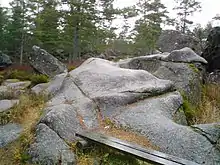Degerfors
Degerfors (Swedish pronunciation: [ˈdêːɡɛrˌfɔʂ])[2] is a locality and the seat of Degerfors Municipality, Örebro County, Sweden, with 7,160 inhabitants in 2010.[1] Degerfors has traditionally been an industrial community closely connected to the large ironworks. The settlement (originally called Johannelund) grew up around this industry and got the status of a municipalsamhälle (a type of borough within a municipality) in 1912. Today it acts as seat of the larger Degerfors Municipality. Degerfors is famous for its successful football team Degerfors IF and for hosting the site of Sveafallen, a geological landscape of small canyons and giant's kettles. There is a narrow-gauge railway connecting it with Bredsjö, the Bredsjö–Degerfors Järnväg.
Degerfors | |
|---|---|
 Degerfors railway station | |
 Degerfors  Degerfors | |
| Coordinates: 59°14′N 14°26′E | |
| Country | |
| Province | Värmland |
| County | Örebro County |
| Municipality | Degerfors Municipality |
| Area | |
| • Total | 7.14 km2 (2.76 sq mi) |
| Population (31 December 2010)[1] | |
| • Total | 7,160 |
| • Density | 1,003/km2 (2,600/sq mi) |
| Time zone | UTC+1 (CET) |
| • Summer (DST) | UTC+2 (CEST) |
Sveafallen

Immediately south of Degerfors lies the nature reserve of Sveafallen.[3] The reserve contains a series of small canyons as well as numerous and large giant's kettles.[3] Sveafallen was long held to be the outlet of the Ancylus Lake, a fresh-water predecessor to the Baltic Sea.[3] The site was first discovered in 1923 by Lennart von Post being the focus of a protracted and sometimes bitter scientific debate that involved not only von Post but also figures such as Henrik Munthe, Astrid Cleve and Curt Fredén.[3][4] The site was initially proposed to be the dry remnant of a dramatic river or waterfall comparable to Niagara Falls.[3][5] Research by Curt Fredén cast well founded doubts on this views[3][4] with the final demise being a 1981 study by Birgitta Ericsson and co-workers showing that the giant's kettles in the area are older than the Ancylus Lake.[4][6] Sveafallen is now believed to have formed by meltwater streams under the Fennoscandian ice sheet.[6]
Sports
Nationally, Degerfors is best known for the football team Degerfors IF. Despite the relatively small size of the town, Degerfors has always had strong local support, and played a total of 29 years in the highest division Allsvenskan. In 1997 the team were relegated and are currently playing in the second highest Swedish league, Superettan.
Another sports club located in Degerfors is Strömtorps IK.
References
- "Tätorternas landareal, folkmängd och invånare per km2 2005 och 2010" (in Swedish). Statistics Sweden. 14 December 2011. Archived from the original on 10 January 2012. Retrieved 10 January 2012.
- Jöran Sahlgren; Gösta Bergman (1979). Svenska ortnamn med uttalsuppgifter (in Swedish). p. 7.
- "Sveafallen". Länsstyrelsen Örebro Län (in Swedish). Retrieved January 3, 2018.
- Björck, Svante (1995). "A review of the history of the Baltic Sea, 13.0-8.0 ka BP". Quaternary International. 17: 19–40. Bibcode:1995QuInt..27...19B. doi:10.1016/1040-6182(94)00057-C.
- Fredén, Curt (1967). "A Historical Review of the Ancylus Lake and the Svea River". Geologiska Föreningen i Stockholm Förhandlingar. 89 (3): 239–267. doi:10.1080/11035896709448372.
- Ericsson, Birgitta; Lidén, Eva; Robertsson, Ann-Marie (1981). "New pothole supports reinterpretation of Svea River". GFF. 104 (1): 95–97. doi:10.1080/11035898209454547.
![]() Media related to Degerfors at Wikimedia Commons
Media related to Degerfors at Wikimedia Commons